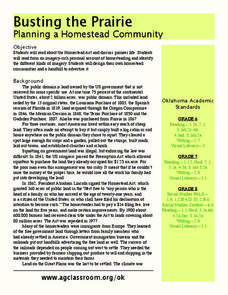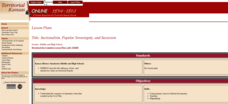Curated OER
The Missouri Compromise of 1820
Students use a map of the Missouri Compromise to explain the geographical changes it brought to the U.S. and why the changes provoked a debate over the expansion of slavery in the U.S.
Curated OER
Causes of the Civil War: Missouri Compromise, Compromise of 1850 and Kansas Nebraska Act
How did the Missouri Compromise, the Compromise of 1850, and the Kansas-Nebraska Act contribute to the growing tensions that led to the Civil war? To better understand the events that led to the Civil War, young historians engage in a...
Curated OER
An Early Threat of Secession: The Missouri Compromise of 1820 and the Nullification Crisis
Students examine the controversies over slavery's expansion and how the federal tariffs further entrenched the dividing line between northern and southern interests.
Curated OER
Cartogram of the Great Compromise
Students create cartograms of populations during 1790.
Curated OER
An Early Threat of Secession: The Missouri Compromise of 1820 and the Nullification Crisis
Students analyze an interactive map of the Missouri Compromise to identify the regions and their relation to slavery. In this pre-civil war era lesson, students read primary source documents and research online to answer questions...
Curated OER
To Compromise or Not to Compromise: The Missouri Question
Students evaluate the fairness of the Missouri Compromise. They read the Missouri Compromise and discuss how it reflected the North-South, anti-slavery and pro-slavery division in the country. They work in groups to debate the Missouri...
Curated OER
Sectionalism, Popular Sovereignty and Secession
Learners read and discuss background material on several key decisions that played a role in the Civil War including the Missouri Compromise, the Kansas-Nebraska Act and the Dredd Scott Decision. They create a timeline and write an essay.
Curated OER
Causes of the Civil War
Students identify the various causes leading to the Civil War. Students create a timeline of the actual events that led to it. Students form small groups and read from one of the included paragraphs about the causes of the war to each...
Curated OER
The Kansas-Nebraska Act of 1854: Popular Sovereignty and the Political Polarization over Slavery
Why did Stephen Douglas support the Kansas-Nebraska Act of 1854? Why did Abraham Lincoln oppose it? Young historians examine how the Kansas-Nebraska Act of 1854 affected the political balance between free and slave states and explore how...
Center for History Education
Lincoln and the Republicans: The Cause of the War?
In today's political rhetoric, many forget the pivotal role the Republican Party played in the causes of the Civil War. The party's formation was the final straw for Southerners who saw the enslavement of people of African descent a...
American Battlefield Trust
Pre-1861: Disunion
Nat Turner, John Brown, and Abraham Lincoln all played a key role in the run-up to the bloody American Civil War. Using a PowerPoint, timeline activity, and essay prompt, young historians consider the roles of these men and more to...
Curated OER
How We Got to Kansas-Nebraska
Learners explore the causes of the Civil War. For this lesson on slavery students use primary sources to examine the evolution of the issue of slavery and in the American political system. Learners will then write a follow-up essay...
Curated OER
The Civil War: A Nation Divided
Discuss the differences between the North and the South and how those differences led to the Civil War. Middle schoolers examine and analyze a famous speech or writing by President Lincoln in order to better understand the speaker's...
Curated OER
Time of Slavery
Young historians learn about abolitionists, The Civil War, Frederick Douglas, and so many more details about slavery in this highly engaging presentation. Teachers could use this as a whole class review and discussion tool.
Curated OER
Running for Freedom: The FUgitive Slave law and the Coming of the Civil War
In order to understand the complicated nature of slave laws during the Civil War, learners compare and contrast an abolitionist poster and a runaway slave ad. They use an attached worksheet to consider each primary source document, then...
Alabama Department of Archives and History
Runaway Slaves in Alabama: Individual Freedom Fighters in the 1800s
Class pairs examine eight runaway slave advertisements from the mid-1800s to develop an understanding of the conditions slaves faced and of race relations.
Curated OER
Popular Sovereignty Under the Kansas-Nebraska Act
Seventh graders examine the implications of the Kansas-Nebraska Act. In this slavery instructional activity, 7th graders examine a map of 1820 America and discuss the balance of power implied by the map. Students then read Stephen...
Curated OER
Sectionalism
Students examine sectionalism. In this sectionalism lesson, students explore reasons sectionalism developed. Students realize the conflicts that led to the Civil War and how sectionalism affected citizens on the border of Kansas and...
Alabama Learning Exchange
Newscast on the Battles of the Ironclad Ships
Fifth graders create multi-media newscasts based on their knowledge of Civil War battles of the ironclad ships.
Curated OER
Busting the Prairie: Planning a Homestead Community
Students research, design and advertise a homestead community. This is an extensive lesson with a variety of ativities and learning experiences.
Curated OER
The Legend of Freedom Hill
Third graders complete pre reading, writing, during reading, and interdisciplinary activities for the book The Legend of Freedom Hill. In this reading lesson plan, 3rd graders complete journal entries, go over vocabulary, answer short...
Curated OER
The Lincoln-Douglas Debates of 1858
Eleventh graders examine transcripts of the 1858 Lincoln-Douglas debates and create a platform for each candidate in the 1858 Senate race.
Curated OER
Sectionalism, Popular Sovereignty, and Secession
Pupils examine sequence of national events that resulted in the Civil War by using primary sources, and creating timelines and maps.
Curated OER
George Washington Bush: A Settlement Journey
Students, in groups, examine the different aspects of George W. Bush's life that led him to settle in the Camas-Washougal area and eventually homestead in Tumwater, Washington. They write a class biography of George W. Bush.
Other popular searches
- The Compromise of 1850
- 1850 Compromise
- Compromise of 1850 Missouri
- Compromise of 1850 Timeline
- Great Compromise 1850
- Missouri Compromise 1850
- Compromise of 1850 Essay
- Compromise of 1850 Webquest
- Compromise of 1850 Mapping
- Compromise of 1850 Web Quest
- Compromise 1850 1820
- Compromise of 1850 Time Line

























